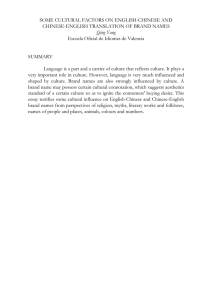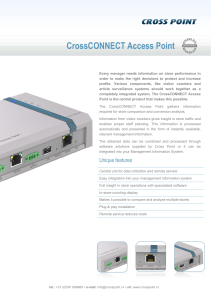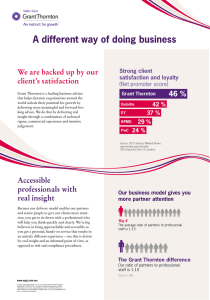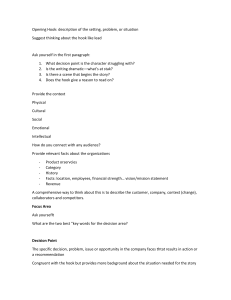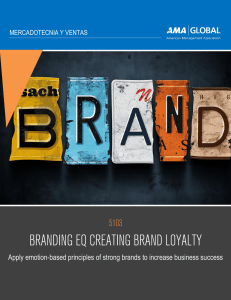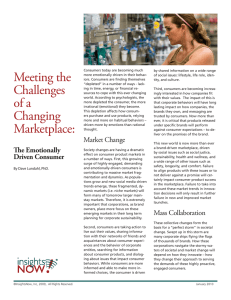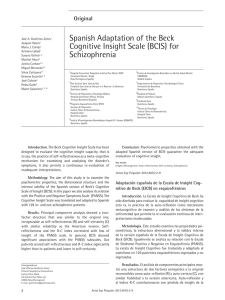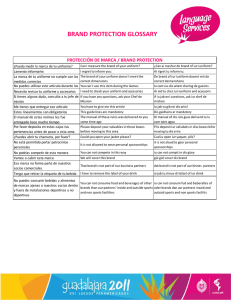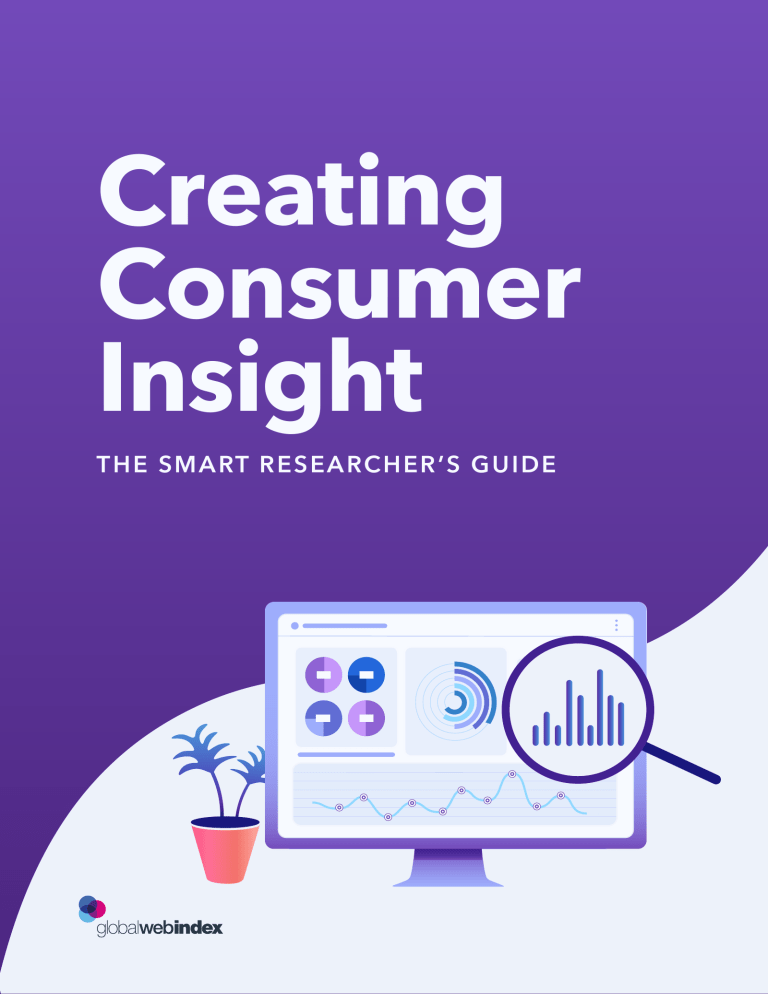
Creating Consumer Insight TH E SM A RT RE SE ARCH E R’S GU IDE 1 Table of Contents Introduction 03 What do we know about today’s consumers? What does this tell us? Chapter 1: The Changing Role of Insight 05 The data-driven present Research vs. insight The anatomy of an insight Chapter 2: The Steps that Matter 13 Creating a pen portrait Turning data into insight Chapter 3: Data vs. Information vs. Insight 19 Starting with data Asking the right questions Chapter 4: Telling Your Story 25 The big truths Shaping your brand to fit From insight to idea Conclusion 33 Creating consumer insight summary 2 Introduction Brands today have access to an endless stream of data, but being data-rich doesn’t mean you have insight. An insight is a universal, human truth about a customer. It reveals something unique about their perceptions and behaviors that you can tap into. Carrying out research deep enough to uncover this helps you create the right message, for the right audience. Integrating this into every stage of a marketing strategy allows for more targeted creativity and a solid ROI. In this guide, we’ll demonstrate how to go from data to insight, and make meaningful connections that last. 3 What do we know about today’s consumers? More than 7 in 10 consumers purchase products online each month. The average internet user has 8 social media accounts, up from 3 in 2012. Millennials spend 2 hours and 38 minutes on social media every day. 46% of 16-24 year-olds use social media for product research. The average consumer spends 6 and a half hours each day using internet-powered devices and services. What does this tell us? As modern consumers become more fragmented across platforms, devices and channels, spending more and more time and money online, brands need to know what works, when, and why. This makes the digital space a challenge for marketers and researchers, but it’s also opening up more opportunities. Having access to insights like the above (and knowing how to use them) is the way to get ahead of your competition. It ensures you know your consumers well enough to offer the experience they’ve come to expect, and you’re in front of the right eyes at crucial times. 4 CH A PT E R 1 The Changing Role of Insight 5 Consumer insight has always been central to effective brand positioning and marketing strategy. Today, it’s taking on a whole new role. Traditionally a lengthy process involving several arms of external research, uncovering an actionable insight took both time and resource. And with the added challenge of juggling several different data sets with varying methodologies; the data not only took too long to get, it wasn’t adding up. Now, every forward-thinking brand knows consumer-centricity is key – something that can only be achieved by putting deep insight in the driving seat. Because in the digital world, insight is everything. The data-driven present ‘Data-driven marketing’ is the buzzword of the decade. But what does it really mean? For us, it’s more of a cultural shift than a tactic. It signifies a move away from educated assumption to more strategic and consumercentric decisions, backed by data. It’s about putting the science behind your best ideas. 6 Then Now Product-centricity Consumer-centricity Lack of data Data overload Broad targeting Hyper-targeting Subjective decisions Data-driven decisions These ideas can range from something as simple as knowing where to place a blog post for maximum reach, to something as big as planning, activating and measuring a multi-million dollar global advertising campaign. Regardless of which end of the spectrum you’re on, businesses are demanding more visibility, accountability and strategic decision-making from their CMOs and marketing teams. In response to this demand, the ease with which you can access robust consumer research is changing too. Research vs. insight But the answer doesn’t lie in extensive research. It lies in deep insight. And yes, there’s a difference. Understanding this difference is where the importance of methodology comes to light. 7 Ultimately, the quality of the insight you retrieve depends on how the research is conducted, and the data collected. Every data provider and research body in existence has a different methodology - a major cause for concern (and headache) among marketing and research professionals trying to make it match. That’s why GlobalWebIndex does it differently. Conducting a global survey that’s fully opt-in, it leverages a panel of 22 million consumers (the largest in the world), to give marketers a true representation of their target audience. Relying on a single source of data like this for your research makes it easier to join the dots and paint a harmonized picture of your target audience. Here’s a snippet of what your research should include. 8 What smart consumer research tells you: Who is it? • • • • Demographics Attitudes Interests Lifestyles What do they do? • Online activities • Media consumption • Online purchase journey Why do they do it? • • • • Motivations Preferences Perceptions Opinions How do they do it? • Social media usage • Device usage 9 The anatomy of an insight Of course, for an insight to be truly impactful, it needs to tick a few boxes. To understand what these boxes are, let’s take a closer look at the anatomy of an insight. IMPACTFUL INSIGHT Targeted Brand fit Human Universal Brand fit Human Does it align with your brand personality and business objectives? Is it a simple truth that is human and easy to identify with? Targeted Universal Is it consistent with your research into this target audience? Can it be distilled into a universal truth that speaks to a wider audience? 10 It’s not good enough for an insight to simply be unique. While consumer-centricity is key, ensuring it’s the right fit for your brand is essential. This tells you that tapping into it could make a visible difference to your business, whether by working to shift perceptions, or to solidify your image in a way that fosters loyalty. Here’s how Snickers put insight into practice. INSIGHT IN PRACTICE Snickers: You’re Not You When You’re Hungry A simple insight into the male psyche fuelled the successful ‘You’re Not You When You’re Hungry’ campaign: There’s a universal code of conduct by which men abide to maintain their position in the male pack. Unveiled through qualitative research into the brand’s target audiences, not only was this insight consistent across regions, it could be distilled into a broader universal truth. “When you’re hungry, you’re just not yourself. And, when you’re not yourself, it has a real impact on your ability to remain part of the pack.” Increasing global sales by 15.9% in its first year alone, the insight-fuelled campaign shaped an original identity that proved the 80-year-old brand was still relevant among its target consumers. Human Universal Brand fit Targeted 11 What made this insight so impactful was a perfect fit for the brand and the target audience: As James Miller, Global Head of Strategy for Mars at BBDO explains: “A relentless focus on effectiveness from the outset right up to today has enabled ‘You’re not you when you’re hungry’ to become one of the world’s best loved and most celebrated campaigns.” 12 CH A PT E R 2 The Steps that Matter 13 Generating impactful insight doesn’t have to be a struggle, but it does require some strategic thinking. Don’t waste time on data that won’t lead anywhere. After all, data on its own is useless; it needs to be granular, relevant to you, and placed in the right context. A comprehensive data source allows you to build your own insights, tailored to your brand, so it’s guaranteed to have an impact. To do this, you need to know the steps to creating a stirring insight. Here’s where to get started. 1. Creating a pen portrait “It is a capital mistake to theorize before one has data.” - Sir Arthur Conan Doyle, Author Reliable consumer personas are important because they tell you exactly what your target audience is doing, and why. Using insight based on granular data (as opposed to more traditional demographic information), you can create wellrounded portraits of your target personas, painting a precise, detailed and holistic picture of your consumer and their path to purchase. Portraits made with this type of robust data are the only ones brands can trust, as they’re built on a solid foundation of absolute truth. Anything else is just guesswork. 14 The five stages of creating a consumer portrait: 1. Find out what their interests are. Determining their interests provides insights into the influencers, the messaging and the tactics that will work for them. 2. Know where they’re spending their time. Identifying where they hang out helps you better understand the platforms and channels they use the most, allowing you to focus your time, effort and budget where it matters. 3. Understand their perceptions. Uncovering how they feel and think about anything from brands and products, to life and lifestyles, allows you to quantify their perceptions. 4. Put yourself in their shoes. By creating ‘day in the life’ collateral based on insight, you can focus on building the empathy that’s needed to make lasting connections. 5. Identify the opportunities. Identifying the most important touchpoints and opportunities for engagement that could guide your strategy in the right direction is essential. Need fast access to the data that paints a complete picture of your consumer? Use GlobalWebIndex to make it specific to your target segment. 15 2. Turning your data into insight While gathering this kind of informative data is essential, it’s what you do with it that really counts. Here’s how to go from a simple data point to a powerful insight. 1. State a clear goal. Determine what you want your insight to achieve. 2. Prioritize your data. Which data sets will yield the results you need? With this knowledge, you won’t get bogged down with irrelevant data. 3. Make it real. Add context to your data to see its true value and meaning. Data may seem useless until it’s made human. 4. Map a day in the life. Use your data to create a map of a typical day for your consumer, shedding light on what they do and why. 5. Finished insight. With a relevant and truthful insight at hand, you’re ready to put it into action. 16 A great example of an organization taking data and overhauling its marketing approach based on insight is Tobacco Free Florida. INSIGHT IN PRACTICE Tobacco Free Florida: The Reasons The Insight In Florida’s rural communities, smoking rates are 33% higher than the rest of the state. This is the unique finding that sparked the creative idea behind Tobacco Free Florida’s latest campaign. Uncovering the fact it’s most often working parents under financial stress, who are sick and tired of the hold that cigarettes have over them, the teams saw an opportunity they could tap into. The Message Across the documentary-style ads telling real stories, one simple message prevails: “There are many reasons to quit. What’s yours?” By putting real people part of rural Florida communities, at the center of the campaign, this authentic message acts to challenge common perceptions around smoking, and the people battling the addiction. Original Hyper-targeted Authentic Universal 17 Why it Worked Since Tobacco Free Florida began airing ads in 2010, the state’s youth cigarette smoking rate has been cut almost in half – from 8.3% in 2010 to 4.3% in 2014 among Floridians aged 13-17. Their latest campaign aims to continue this trend, using consumer insight to form a unique and original angle, far from the anti-smoking campaigns we’re used to seeing. The campaign not only works to strike a chord among smokers, it also pleads with the wider public to think twice about shaming someone into quitting; Because just maybe, behind the ‘bad habit’ is a painful story of regret and longing. Brand fit 18 CH A PT E R 3 Data vs. Information vs. Insight 19 The goal is to turn data into information, and information into insight. Carly Fiorina, former CEO of Hewlett-Packard 20 With so much data out there, it’s easy to get confused about where this sits in the quest for truth. Let’s not forget, there’s an important hierarchy that exists in consumer research. While everything starts with data, it’s through a careful process of getting more granular and targeted, more aligned and focused, that this insight comes to light. Insight Information Data Insight Information Data Universal truth Collection of data points Raw numbers 21 Starting with data Getting started with data means choosing the sources that are right for you. Like everything, this means asking the right questions. Here are a few to get you started. Questions to consider: • What kind of data do I need? • What questions do I need to answer? • Is it first or third party data? • Is it qualitative or quantitative research? • How up-to-date is it? • How accurate is it? • How easily can I extract insights? • How will it be used across the business? • How will I measure the value of my data? • How are others successfully leveraging consumer data? Gather the research that’s trusted, deep and specific to your target audience and market. The more you leverage sources that give you enough relevant information to work with, the more actionable your insights will be. 22 Data Comparison Information Context Insight 23 Asking the right questions Think carefully about what you want to know and map out the questions that will get you the answers. Questions your data should answer: • How do they spend their time online? • Which social platforms are they most active on? • How do they interact with my brand? • How do they typically discover new brands? • Where do the opportunities for interaction exist? • What are they most interested in? • How do they perceive my brand? • What motivates them to make a purchase? • What fosters brand loyalty among them? Always start by exploring the research and methodology of the data provider you’re looking at to ensure its methods are accurate, reliable and ethical. 24 CH A PT E R 4 Telling Your Story 25 “If the statistics are boring, then you’ve got the wrong numbers.” - Edward R. Tufte, Statistician Every insight tells a story about your target audience, but the key to success lies in how you tell it. Ask yourself: What story will resonate with this audience? Finding an answer to this question means sourcing the big truths. The big truths Expansive, granular consumer data can offer up endless truths about your target audience. Amid these, it’s crucial to identify the ones that will lead to great ideas, and the ones that won’t. ‘Big truths’ are relevant, revealing and aligned, lending a solid foundation for truly actionable insights. Here’s how to identify a big truth for your brand. 26 The core elements of a big truth Relevance: The insight is not only interesting, it’s relevant and unique to your brand. Timing: It’s come at the right time, and you’re in a place where you can use it. Originality: It’s generating new creative ideas and won’t lead to an experience your consumer has had a thousand times before. Feasibility: You have the time and resource to use it. Shaping your brand to fit Uncovering a universal truth about a consumer is where the magic happens, but making sure it aligns with your brand is key. Reliable data harvested straight from the consumers themselves is the only failsafe way to know, ahead of time, your brand’s moving in the right direction. But again; data (and insight) is useless without context and action. 27 Any powerful idea is absolutely fascinating and absolutely useless until we choose to use it. Richard Bach, Author 28 Here’s an example of a global brand tapping into insight in a meaningful way. INSIGHT IN PRACTICE BuzzFeed The Challenge Our data shows 1 in 2 internet users between 18-34 in the U.S. engage with BuzzFeed on a monthly basis. This highlights the company’s status as a go-to source for content among millennials. But with continued growth, the brand needed to prove its appeal stretches far beyond this key demographic, driving advertising revenue. The Action Focusing first on their Australian market, the in-house teams decided to make use of deep insights into their audiences from GlobalWebIndex to challenge perceptions and spark new conversations. Creating a string of targeted newsletters outlining some of their most impactful finds, the teams used this data to prove their mass appeal. Starting with mums, they shared insights into audiences often overlooked in connection to BuzzFeed. The Result Positioning themselves as experts on their consumers while simultaneously proving their appeal to far more than just millennials, BuzzFeed effectively used deep insights to drive new business and build trust among clients. 29 From insight to idea “An insight is the start of possibly hundreds of ideas.” - Kristof De Wulf, Co-Founder & CEO, InSites Consulting With your insight at hand, you can take the final step to the great idea that will generate the results you want. Any one insight could generate an endless number of ideas, but sparking the best ones comes with careful brainstorming, planning and alignment. One tip is to maintain a core focus on the perceptions you’re looking to shift. This will ensure you don’t lose focus from the overall goal and you can separate the good ideas from the great ones. Here’s a classic example of a brand getting to their perfect campaign idea through consumer insight. 30 INSIGHT IN PRACTICE Always: Keep Going #LikeAGirl At puberty, 49% of girls feel paralyzed by the fear of failure, leading them to avoid trying new things. This insight sparked an idea that allowed Always to expand on its original message, empowering girls to tackle this fear and ‘keep going #LikeAGirl’. Originally launched in 2014, this multi award-winning marketing effort successfully positioned the brand as an ambassador for female empowerment and social change. In 2017, the campaign’s message was adjusted to encourage girls to embrace failure and learn from it, rather than be discouraged by it. This long-running campaign continues to break barriers and challenge social perceptions, all the while evolving its empowering message. Its success is primarily due to its insight-driven approach that puts perceptions at the forefront – and with 70% of women and 60% of men saying the original campaign changed their perception of the phrase ‘like a girl’ for the better, it’s clearly a tactic that pays. This shows the true power of relevant, reliable insight, and how one solid finding can shape your marketing for years to come. 31 Here’s a handy checklist to keep you on track. Connection. The idea is relevant to our brand and will resonate with our story. Expression. We can communicate the idea effectively through creative messaging. Resource. It’s possible for our brand to do the idea justice. Measurement. We can identify the potential ROI on the idea, and measure its success. 32 Conclusion In today’s oversaturated marketing climate, having the data to back you up is crucial. That said, it’s easy to get lost in this sea of data. It’s equally as easy to get confused about what constitutes an insight, and one that will work for you. But being able to unearth the kind of universal truth that’s tailored to your brand is worth the challenge. Here’s why: • It gives you the ability to take a truly consumer-centric approach. • It ensures less spend is wasted, as you know the audiences, channels and tactics to focus on. • It creates opportunities for more authentic marketing communications. • It drives a greater ROI, with a streamlined data process you can trust. Using a reliable source of deep consumer data like GlobalWebIndex, going from raw data to impactful insight is simpler than ever. With ready access to everything you need to know about your target consumers, you can uncover the big truths that will hit home, and put the science behind your best ideas. 33 About GlobalWebIndex As home of the world’s largest survey on the online consumer, with data representing 2.6bn internet users across 44 countries, the GlobalWebIndex platform makes it easy to achieve personalization at scale. Sign Up Free 34

